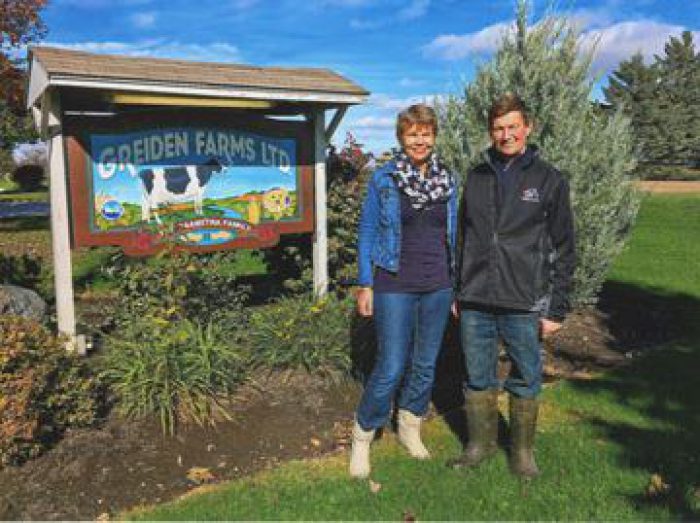Greiden Farms cracks top 10 in Canada for well-managed dairies
As published in the St. Mary's Journal Argus, written by By Stew Slater
Haanstra family has been inching their way up the DHI list since arriving from the Netherlands 25 years ago

Photo courtesy of the Haanstras
Moving up two positions on a Canada-wide list of well-managed dairy farms doesn’t, at first glance, seem like a momentous occasion for Greiden Farms. The Uniondale-area business operated by the Haanstra family has, after all, been included on the list consistently over the past several years.
But when a farm moves from Number 11 to Number 9, and the organization compiling the list makes a practice of releasing to the media a “Top 10” announcement on an annual basis, it becomes big news.
And so it was earlier this month for Greiden Farms, as Cees and Hinny Haanstra began receiving congratulations for their achievement even before the CanWest Dairy Herd Improvement (DHI) Association officially released its “Top 10” for 2016.
DHI bases its “Well-Managed Herds” list on six of the more than a dozen parameters it monitors on behalf of dairy farmers who choose to use its services. Those parameters — some of which are self-explaining; others of which (like “milk value”) are more complex and take into account other parameters as well — are: milk value, udder health, calving interval, age at first calving, herd efficiency, and longevity.
In short, if a dairy farm succeeds in meeting target values for those parameters, DHI surmises that, for each dollar spent on feeding and caring for their cows, they’ll earn a greater financial return than a farm which doesn’t succeed in meeting those targets.
On Jan. 9 of this year, the Haanstras celebrated 25 years since relocating to Canada from a dairy farm in the Netherlands. During a visit by the Journal Argus to their farmhouse, Cees recalled the family built a freestall barn for 160 cows, started out with 125 milking, and soon expanded to fill the space and more.
Now, they milk approximately 600 cows in a double-11 herringbone parlour, with expanded freestall housing and a heifer facility on a farm up the road from the main dairy barn. They’ve built up their land holdings from the original 200 acres owned and 200 acres rented, and with eldest sons Arjan and Rolf now ready to take over management of their own dairies (younger son Hilco and daughter Eline work in non-farm jobs), the next step is splitting the operation into two separate businesses through the construction of a new facility on recently-purchased land near Lakeside.
“Our policy always was for the kids to finish school, go and work somewhere else to see how things are done in other places, and then if they wanted to come back and work here, they could,” Cees commented.
Cows are milked three times daily at Greiden Farms, with Cees well-known among the dairy farming community in this region for insisting that he does all the hoof-trimming at the farm. When the milking facility was expanded, he made sure to design a hoof-trimming pen inside the barn into which animals could easily be brought from all different housing areas.
Every January, DHI hosts three “Herd Management Conference” events across Ontario, each on a different day featuring the same speaker program. This year, Cees Haanstra was one of those speakers, with a presentation entitled “Protocols and Practices of a Well-Managed Herd.”
Wrapping up those presentations, he recalled, he stressed to the dairy farmers gathered in the rooms a three-word phrase: “All the details.”
Haanstra says it comes down to effectively managing your crops, managing your cows, and managing your employees. “Because, with the size of the farms now, you can’t do it all yourself. So you have to make sure your employees have the same goals as you do.”
He adds that ensuring your herd has strong genetics certainly is advisable. And working with experts so the feed ration being eaten by the cows is a must. But the real key is making sure those two factors are dealt with simultaneously because if a farm is only strong in one and weak in the other, milk production and herd health will suffer.
Employees, too, must see things the same way. And with Greiden Farms, that has been the case, Haanstra says. “Our success is also due to our dedicated loyal employees; without them, we cannot get the work done. They are a valuable asset and we would like to recognize them, too, in this achievement
Cees insists, though, that moving up towards the top of DHI’s Canada-wide list isn’t something he thinks about. “I don’t have to be number one. It’s not like that’s a goal,” he said.
“Besides, if there’s somebody ahead of you, you know you still have improvements to make.”
Stew Slater is the Editor at the St. Marys Journal Argus. He can be reached at sslater@stmarys.com. Follow the Journal on Twitter and Facebook.
Back To News



